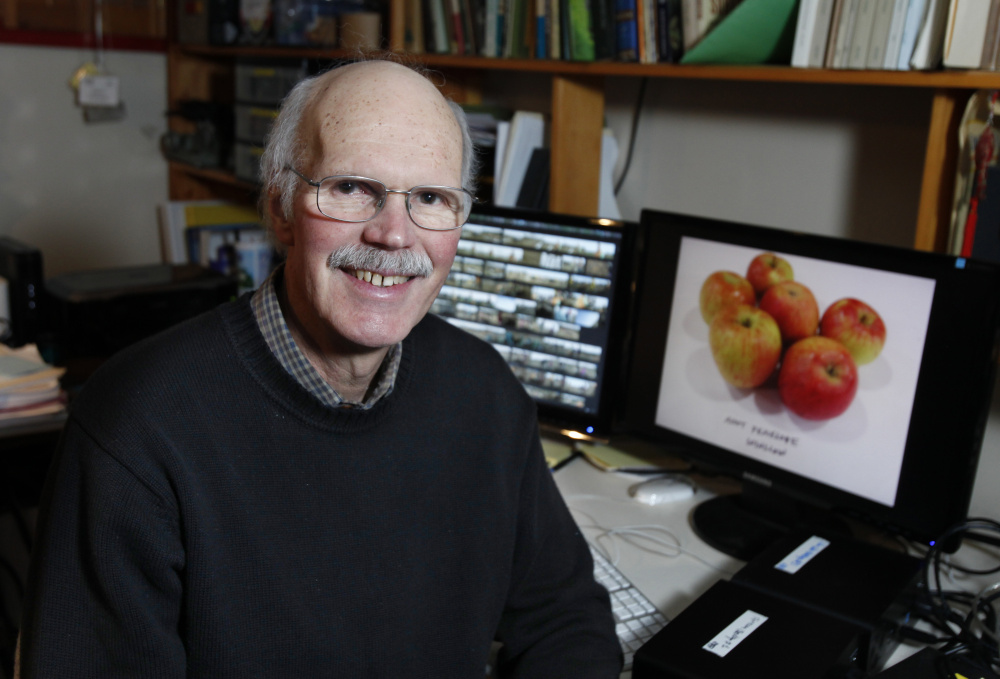Filmmaker Huey Coleman is naturally disposed to films with an environmental bent. He’s made a documentary about Mount Katahdin and is in the process of making one about Henry David Thoreau. But his latest film, “Maine Heritage Orchard,” about the fruit orchard under development at the Maine Organic Farmers and Gardeners Association headquarters in Unity, has a special connection to Coleman’s college days. Coleman went to Colby College with the force behind the orchard, apple expert and 1970s back-to-the-lander John Bunker. Not long before the film’s Portland premiere as part of the 2016 Maine Short Film Festival, we talked with Coleman about filmmaking, farming and that time he briefly went back to the land himself.
COLLEGE DAYS: Coleman arrived at Colby in the late 1960s planning to be a math major. “That lasted for a semester.” He ended up studying philosophy, religion and art. He studied with Abbott Meader, an artist and filmmaker who introduced underground film to the campus. “It wasn’t just the art department majors that would show up. It was the hip thing of the day.” Meader let him use Colby’s lone film camera at the time. “It must have been a Super 8,” Coleman recalled. “So I made a very bad student film, but I learned and made some other films, and Abbott has been my mentor ever since.” Meader helped him with his film “Wilderness & Spirit: A Mountain Called Katahdin.”
THE GRADUATE: With the spirit of change fomenting on campus and his copy of Maine residents Helen and Scott Nearing’s book “Living the Good Life” close at hand, Coleman was drawn to the back-to-the-land movement, so much so that he and Bunker and a third classmate went shopping for land to farm together. He no longer remembers who floated the idea or who called up the real estate agent. But he does remember snowshoeing around the land they found in Palermo. “It was late in the winter and there was snow cover, but it was a warmish day.” There were more than 100 acres, and they had to break trail. “It was challenging to get around.” Also, there were no buildings. But the land was $25 an acre. They bought it all, jointly. “It was a stretch. I think it was near graduation. Maybe we had some graduation gifts?”
SUPER CHILL: “We wanted to learn. We knew that apple trees were important because you could eat apples all year. The first thing we did was clear land. John built everything. We did have a garden, and one of the local farmers gave us advice.” But Coleman didn’t last long as a back-to-the-lander. “When we bought it, we were clueless and (then) I realized, ‘Oh, I am a filmmaker. This isn’t going to work.’ ” Their third friend eventually left as well, and today that land is Bunker’s Super Chilly Farm (and orchard). Coleman went on to education, traveling around the state to teach filmmaking to high school students. “That became my bread and butter, and I would do my own films in between.” For the last eight years, he has taught filmmaking at Southern Maine Community College.
OLD FRIENDS: But the connection with his old college friend remains; it was Bunker who asked Coleman to document the creation of the new orchard as he and volunteers planned for the first planting day in spring of 2014. MOFGA came up with the funding for the film. At that point, Bunker and his crews had already done a tremendous amount of work to reclaim the former gravel pit MOFGA had designated for the orchard, creating terraces along what had been the steep sides of the pit. They spent the winter making plans, and Coleman arrived, camera in hand, to document the first planting of 102 tiny trees. “This was a vision John had for many years,” Coleman said. Coleman returned in the spring of 2015 to film the next batch of 80 trees being planted, all by volunteers, including schoolchildren. “Seeing this mix of elders and all these young people that want to work on farms – it is great for the state. I was documenting this heritage orchard, which is important, but we are also heralding this new movement, a movement that will keep preserving our heritage.'”
MUSEUM OF FRUIT: The 10-acre orchard will eventually house 500 varieties of apple and pear trees that have traditionally grown in Maine, protecting and preserving those varieties. Bunker and the late Russell Libby, who was the longtime executive director of MOFGA, developed the concept. It has a double purpose, first as almost a seed, or rather scion, library for these Maine fruits. “A living museum,” Coleman said. It’s also a way to show visitors and Common Ground Fair attendees how even abused land stripped of topsoil can be brought back to life. That’s the vision anyway. “You have some of the best minds of agriculture working on it. It should work,” Coleman said.
COMING SOON: Coleman’s film on Thoreau has been in the works for years. He’s filmed in many of the locations Thoreau spent time in in Maine, and he’s also shot a lot of footage at Walden Pond. The film covers the Thoreau of the past, including his relationship with the Penobscot tribe, and the Thoreau who continues to inspire. “I want to show Thoreau’s impact today,” Coleman said. He aims to have it ready for release around July 2017, which is the 200th anniversary of Thoreau’s birth. In the meantime, the spring planting of 2016 at the Maine Heritage Orchard could call to him. “We haven’t talked about documenting Year Three, but who knows? Maybe I will show up with my camera,” Coleman said.
Send questions/comments to the editors.



